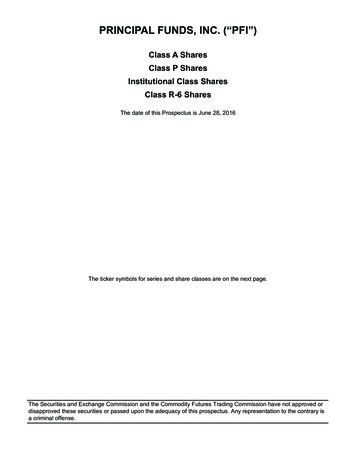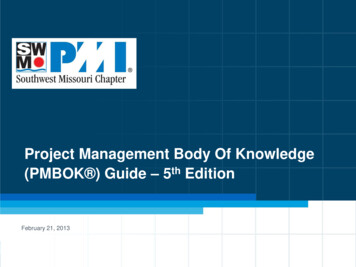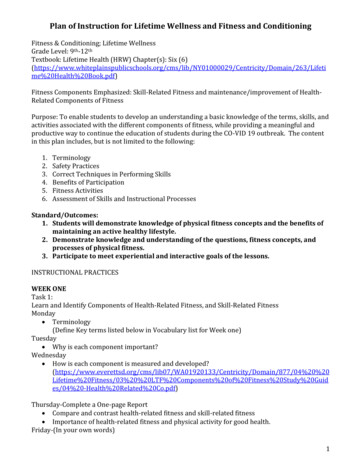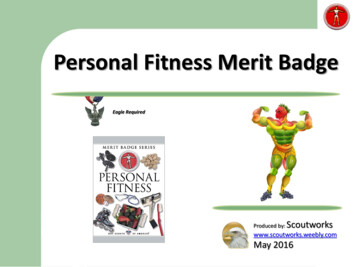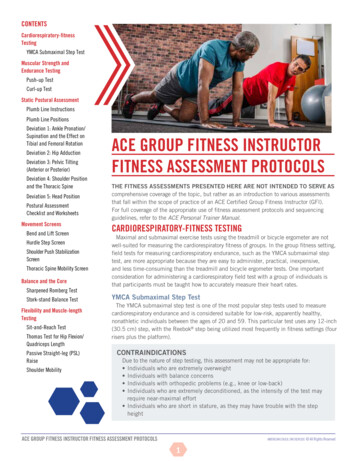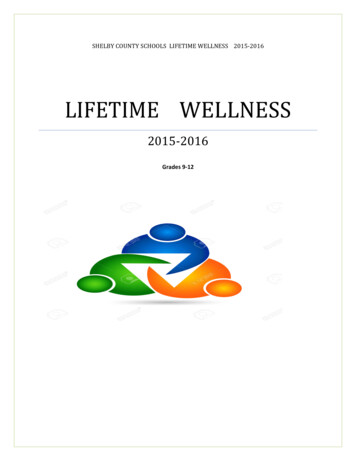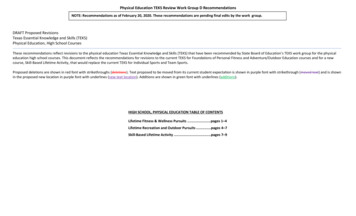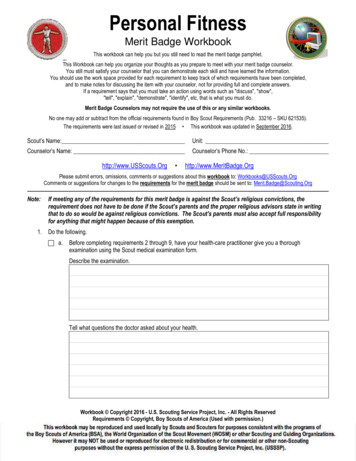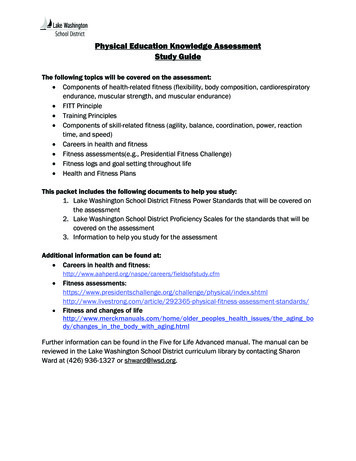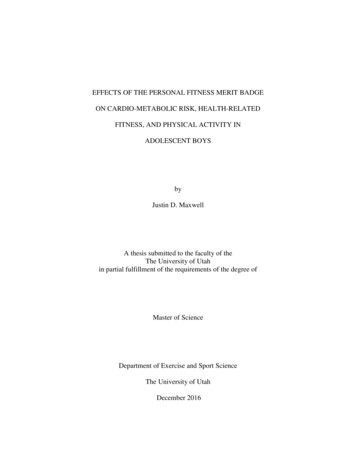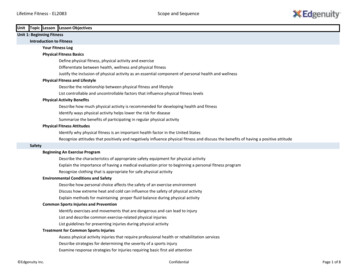
Transcription
Lifetime Fitness - EL2083UnitScope and SequenceTopic Lesson Lesson ObjectivesUnit 1: Beginning FitnessIntroduction to FitnessYour Fitness LogPhysical Fitness BasicsDefine physical fitness, physical activity and exerciseDifferentiate between health, wellness and physical fitnessJustify the inclusion of physical activity as an essential component of personal health and wellnessPhysical Fitness and LifestyleDescribe the relationship between physical fitness and lifestyleList controllable and uncontrollable factors that influence physical fitness levelsPhysical Activity BenefitsDescribe how much physical activity is recommended for developing health and fitnessIdentify ways physical activity helps lower the risk for diseaseSummarize the benefits of participating in regular physical activityPhysical Fitness AttitudesIdentify why physical fitness is an important health factor in the United StatesRecognize attitudes that positively and negatively influence physical fitness and discuss the benefits of having a positive attitudeSafetyBeginning An Exercise ProgramDescribe the characteristics of appropriate safety equipment for physical activityExplain the importance of having a medical evaluation prior to beginning a personal fitness programRecognize clothing that is appropriate for safe physical activityEnvironmental Conditions and SafetyDescribe how personal choice affects the safety of an exercise environmentDiscuss how extreme heat and cold can influence the safety of physical activityExplain methods for maintaining proper fluid balance during physical activityCommon Sports Injuries and PreventionIdentify exercises and movements that are dangerous and can lead to injuryList and describe common exercise-related physical injuriesList guidelines for preventing injuries during physical activityTreatment for Common Sports InjuriesAssess physical activity injuries that require professional health or rehabilitation servicesDescribe strategies for determining the severity of a sports injuryExamine response strategies for injuries requiring basic first aid attention Edgenuity Inc.ConfidentialPage 1 of 8
Lifetime Fitness - EL2083UnitScope and SequenceTopic Lesson Lesson ObjectivesFitness FundamentalsPrinciples of ExerciseApply the training principles of overload, progression, and specificity to physical activityDescribe the components of FITT (Frequency, Intensity, Time, and Type)Identify proper procedures and benefits of warming up and cooling downHealth-related FitnessDescribe strategies for assessing health-related fitness levelsIdentify activities which improve the components of health-related fitnessList and define each of the five health-related fitness componentsSkill-related FitnessDescribe strategies for assessing skill-related fitness levelsIdentify factors that influence skill-related fitness levelsList and define each of the six skill-related fitness componentsFitness EvaluationDiscuss the factors involved in conducting a fitness evaluation using national fitness testsInterpret the results of a fitness evaluationSet personal fitness goals based on the results of a fitness evaluationBiomechanical PrinciplesMovementDescribe the effects of energy and force on movement using acceleration and velocityExplain the three classes of levers present in the human body and demonstrate their use in physical activityStability & Range of MotionDescribe strategies for improving stabilityDescribe the relationship between joints and range of motionIdentify the six types of jointsIntegrated MovementDescribe the relationship between efficiency and energy useList external forces that provide resistance to human movementUse the principles of biomechanics to describe an integrated system of human movement Edgenuity Inc.ConfidentialPage 2 of 8
Lifetime Fitness - EL2083UnitScope and SequenceTopic Lesson Lesson ObjectivesUnit 2: Health-related FitnessCardiorespiratory FitnessThe Cardiovascular and Respiratory SystemsDescribe proper care of the cardiovascular and respiratory systems to avoid diseaseDescribe the functions and structures of the cardiovascular systemDescribe the functions and structures of the respiratory systemCardiovascular DiseasesDescribe common types of cardiovascular diseaseList ways to identify, treat, and prevent cardiovascular diseaseSummarize how one's lifestyle can contribute to cardiovascular diseasePhysical Activity and Cardiorespiratory FitnessDemonstrate methods for assessing cardiorespiratory fitnessDescribe the affect of physical activity on the cardiovascular and respiratory systemIdentify factors that influence cardiovascular and respiratory fitness levelsDeveloping Cardiorespiratory FitnessApply the exercise principle of overload to improve cardiovascular healthDescribe how the exercise principle of progression leads to improved cardiovascular healthDifferentiate between aerobic and anaerobic exercise using the exercise principle of specificityExploring Activities for Cardiorespiratory FitnessCompare multiple aerobic activities for their ability to promote cardiorespiratory fitnessDetermine safety considerations when performing aerobic activitiesRecognize exercise considerations for those with special needsMuscular FitnessThe Skeletal, Muscular, and Nervous SystemsDescribe the structures and proper care of the of the skeletal systemDescribe the structures of the nervous system and identify injuries and diseases the affect the nervous systemSummarize the muscular system, including the functions, types of muscles, and problems associated with the systemMuscular Strength and EnduranceDescribe how muscles work and growDifferentiate between muscular strength and muscular enduranceExplain how muscular strength and endurance contribute to good health and fitness Edgenuity Inc.ConfidentialPage 3 of 8
Lifetime Fitness - EL2083UnitScope and SequenceTopic Lesson Lesson ObjectivesDeveloping Muscular Strength and EnduranceApply exercise principles to develop muscular strength and enduranceDemonstrate methods for assessing muscular strength and enduranceEvaluate the components of weight training in order to design an appropriate personal programSafe Weight TrainingDemonstrate proper spotting techniquesDescribe proper safety procedures for participating in a weight training programDescribe the effects of supplements and drugs that are marketed to active people and athletesExploring Exercises for Muscular FitnessEvaluate the differences between weight-training techniquesIdentify exercises which develop muscular strength and enduranceRecognize myths associated with weight trainingFlexibilityFactors Influencing FlexibilityDescribe the characteristics of flexibility and factors that influence flexibility levelsIdentify health benefits associated with flexibilityPhysical Activity and FlexibilityApply exercise principles to developing flexibilityDemonstrate methods for assessing flexibilityExplain the different types of stretching exercises and how they affect musclesSafe and Effective StretchingDescribe a variety of stretching exercisesIdentify stretching exercises that are harmful and should be avoidedList guidelines for doing flexibility exercises safelyNutritionFood and HealthAnalyze the relationship between nutrition, health, and wellnessDescribe the functions of the six basic nutrients in maintaining healthRecall common nutrition terminologyNutritional NeedsAssess nutritional needs based on dietary guidelines and the Food Guide PyramidDescribe how nutritional needs change throughout the lifespanFormulate healthy meal plans and snacks as part of a balanced diet Edgenuity Inc.ConfidentialPage 4 of 8
Lifetime Fitness - EL2083UnitScope and SequenceTopic Lesson Lesson ObjectivesGuidelines for Healthy EatingAnalyze the conditions that lead to the spread of common foodborne illnessesAnalyze the information on food labels and apply it to make better food choicesRecognize common myths regarding nutritionBody CompositionHealthy Body CompositionDefine body composition and describe the importance of body fatDescribe genetic, physiological, and lifestyle factors that influence body compositionIdentify health-related problems associated with abnormal percentages of body fatDetermining and Controlling Body CompositionAnalyze additional strategies for achieving or maintaining a healthy body compositionApply the exercise principles to controlling body compositionDescribe methods for determining body composition, including Body Mass IndexDietsDescribe common dietary restrictions and trendsDifferentiate between multiple meanings of dietIdentify additional harmful diets and weight-loss strategies and their effects on the bodyBody Image and Eating DisordersDevelop a methodology for improving body imageDiscuss the relationship between body image and eating disorders, including the influence of the media on body imageList the symptoms and health dangers of the most common eating disordersUnit 3: Skills for Lifelong FitnessIntroduction to SportsTeam SportsDescribe how participating in team sports benefits the dimensions of healthIdentify team sports that achieve health-related fitness goals in both school and outside of schoolList common characteristics of team sports, including offense, defense, and officialsIndividual SportsDescribe how participating in individual sports benefits the dimensions of healthExplain why participating in individual sports is enjoyable and desirableIdentify individual sports that help to achieve health-related and skill-related fitness goals Edgenuity Inc.ConfidentialPage 5 of 8
Lifetime Fitness - EL2083UnitScope and SequenceTopic Lesson Lesson ObjectivesSkills and TacticsDescribe strategies used to play team sportsIdentify skills important for participating in physical activitiesIdentify techniques for improving your performance when participating in sportsParticipating in SportsDefine competition and describe what it means to competeDescribe sportsmanship and why it is important when participating in sportsSummarize necessary responsible behaviors when participating in sportsBeing a Good SportDescribe sports etiquette and ethicsIdentify and apply the rules of safe sports participationSummarize an official's role in team sportsDiversity in SportsExamine athletic limitations and differences in yourself and othersExplore sports and activities of other countries and culturesExplore techniques for including peers of all ability levels in sports activitiesSkills for Success in AthleticsLeadershipDefine leadershipList the traits, characteristics, and mannerisms associated with effective leadersRecognize and identify leadership styles and situations that are appropriate for using themConflict ManagementDemonstrate an understanding of conflict resolution strategiesIdentify the causes of conflictRecognize factors that influence conflict resolutionCommunicationDescribe the communication process and effective and ineffective communicationDevelop speaking, listening, and nonverbal communication skills necessary for building healthy relationshipsDifferentiate between passive, assertive, and aggressive communication stylesStress ManagementStress and HealthDescribe how people react to stress physically, emotionally, and behaviorallyExplain common sources of stressRecognize the relationship between stress and disease Edgenuity Inc.ConfidentialPage 6 of 8
Lifetime Fitness - EL2083UnitScope and SequenceTopic Lesson Lesson ObjectivesCoping with StressDescribe positive and negative strategies for coping with stressDevelop healthy behaviors that help reduce stressTime ManagementExplain the different between free time and committed timeList a variety of strategies for managing timeDesigning a Personal Fitness PlanSetting Healthy GoalsDevelop an action plan to achieve a personal goalDifferentiate between long-term goals and short-term goalsIdentify guidelines that should be followed when setting goalsActivity SelectionAnalyze common exercise programs and sports activitiesDescribe how personality, attitude, and available resources affect the selection of exercise programs and sports activitiesIdentify health needs that affect participation in activitiesYour Fitness PlanDescribe strategies that can help maintain a fitness program over the long termExplain the steps for putting together a successful personal fitness programTailor a fitness program to accommodate different life stagesConsuming WiselyMaking Consumer ChoicesAnalyze health messages delivered through advertisements in the mediaDescribe factors that influence consumer decisions about health products, procedures, and informationExplore the ways in which technology affects the accessibility and reliability of healthcare informationChoosing Health ServicesAnalyze the cost and accessibility of heath services for all peopleDescribe health care services that are available in the community and how they relate to disease prevention and health promotionEvaluate health and fitness professionalsDealing with Consumer IssuesExplain methods for addressing critical health issues that result from fraudIdentify government agencies, consumer groups, and business organizations in the community and world that advocate for consumer rightsList and describe common health-related and fitness-related fallacies Edgenuity Inc.ConfidentialPage 7 of 8
Lifetime Fitness - EL2083UnitScope and SequenceTopic Lesson Lesson ObjectivesFitness Centers and EquipmentConsider the factors related to the selection, purchase, care and maintenance of physical fitness equipmentDevelop criteria for evaluating fitness centersLifetime FitnessAging and FitnessDescribe the importance of physical fitness for all ages and abilitiesExplore how exercise can be modified to include family participationIdentify the changes that occur as the body agesLifetime FitnessDescribe the benefits of lifetime fitnessExplore popular activities that are common among people seeking lifetime fitnessIdentify and explain characteristics that help people become and remain activeFitness and Wellness CareersDiscuss the educational requirements for varying careers in the fitness and wellness industryIdentify a variety of fitness and wellness career opportunitiesList the pros and cons of working in the fitness and wellness industry Edgenuity Inc.ConfidentialPage 8 of 8
Lifetime Fitness - EL2083 Scope and Sequence Unit Topic Lesson Lesson Objectives Fitness Centers and Equipment Consider the factors related to the selection, purchase, care and maintenance of physical fitness equipment Develop criteria for evaluating fitness centers Lifetime Fitness Aging and Fitness
